For the 2025 school year, there are 2 public elementary schools serving 524 students in South Harrison County R-II School District. This district's average elementary testing ranking is 6/10, which is in the top 50% of public elementary schools in Missouri.
Public Elementary Schools in South Harrison County R-II School District have an average math proficiency score of 43% (versus the Missouri public elementary school average of 40%), and reading proficiency score of 40% (versus the 42% statewide average).
Minority enrollment is 9% of the student body (majority Hispanic), which is less than the Missouri public elementary school average of 32% (majority Black).
Overview
This School District
This State (MO)
# Schools
5 Schools
1,747 Schools
# Students
790 Students
575,116 Students
# Teachers
81 Teachers
46,819 Teachers
Student : Teacher Ratio
12:1
12:1
District Rank
South Harrison County R-II School District, which is ranked within the top 50% of all 553 school districts in Missouri (based off of combined math and reading proficiency testing data) for the 2021-2022 school year.
The school district's graduation rate of 85-89% has decreased from 90% over five school years.
Overall District Rank
#193 out of 557 school districts
(Top 50%)
(Top 50%)
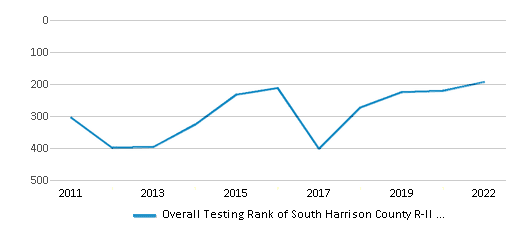
Math Test Scores (% Proficient)
43%
39%
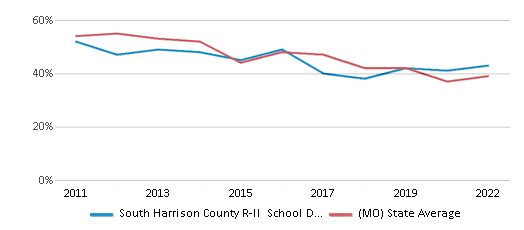
Reading/Language Arts Test Scores (% Proficient)
43%
43%

Science Test Scores (% Proficient)
30-34%
38%
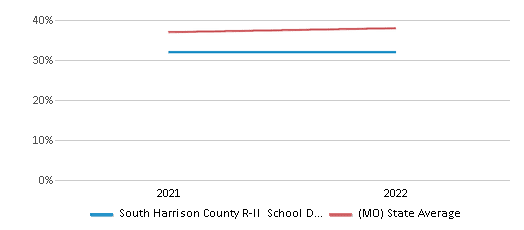
Graduation Rate
85-89%
90%
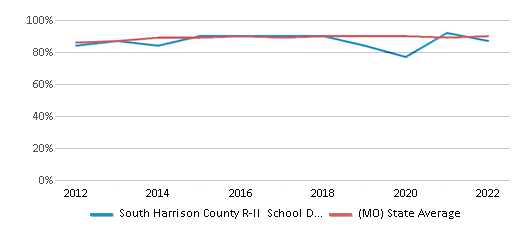
Students by Ethnicity:
Diversity Score
0.15
0.51
# American Indian Students
2 Students
2,038 Students
% American Indian Students
n/a
n/a
# Asian Students
8 Students
12,320 Students
% Asian Students
1%
2%
# Hispanic Students
24 Students
47,223 Students
% Hispanic Students
3%
8%
# Black Students
1 Student
89,252 Students
% Black Students
n/a
16%
# White Students
727 Students
389,099 Students
% White Students
92%
68%
# Hawaiian Students
n/a
2,412 Students
% Hawaiian Students
n/a
n/a
# Two or more races Students
28 Students
32,772 Students
% of Two or more races Students
4%
6%
Students by Grade:
# Students in PK Grade:
-
19,285
# Students in K Grade:
50
59,679
# Students in 1st Grade:
54
62,780
# Students in 2nd Grade:
53
65,110
# Students in 3rd Grade:
65
63,746
# Students in 4th Grade:
57
64,813
# Students in 5th Grade:
62
64,811
# Students in 6th Grade:
64
65,222
# Students in 7th Grade:
54
48,663
# Students in 8th Grade:
65
48,580
# Students in 9th Grade:
61
3,086
# Students in 10th Grade:
66
3,116
# Students in 11th Grade:
64
3,104
# Students in 12th Grade:
75
3,121
# Ungraded Students:
-
-
District Revenue and Spending
The revenue/student of $12,284 in this school district is less than the state median of $15,081. The school district revenue/student has grown by 5% over four school years.
The school district's spending/student of $12,301 is less than the state median of $13,908. The school district spending/student has grown by 5% over four school years.
Total Revenue
$10 MM
$13,447 MM
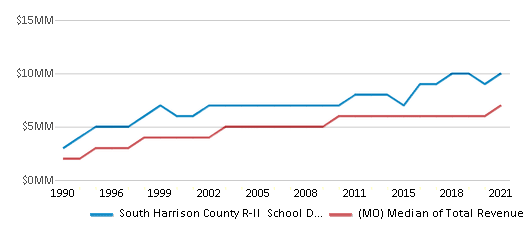
Spending
$10 MM
$12,401 MM
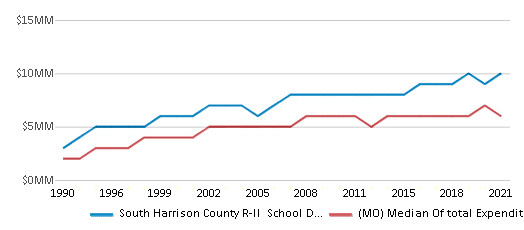
Revenue / Student
$12,284
$15,081
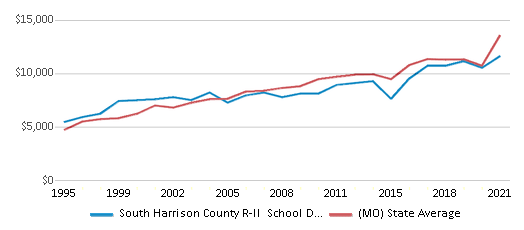
Spending / Student
$12,301
$13,908
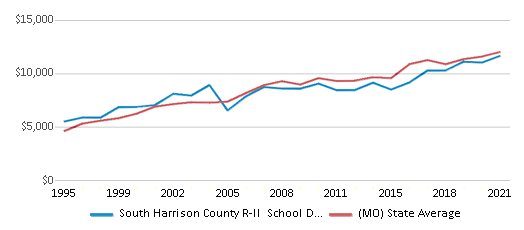
Best South Harrison County R-II School District Public Elementary Schools (2025)
School
(Math and Reading Proficiency)
(Math and Reading Proficiency)
Location
Grades
Students
Rank: #11.
South Harrison Elementary School
(Math: 40-44% | Reading: 45-49%)
Rank:
Rank:
7/
Top 50%10
2213 Beekman
Bethany, MO 64424
(660) 425-8061
Bethany, MO 64424
(660) 425-8061
Grades: K-4
| 279 students
Rank: #22.
South Harrison Middle School
(Math: 44% | Reading: 37%)
Rank:
Rank:
6/
Top 50%10
3400 Bulldog Ave
Bethany, MO 64424
(660) 425-7467
Bethany, MO 64424
(660) 425-7467
Grades: 5-8
| 245 students
Recent Articles

Year-Round Or Traditional Schedule?
Which is more appropriate for your child? A year-round attendance schedule or traditional schedule? We look at the pros and cons.

Why You Should Encourage Your Child to Join a Sports Team
Participating in team sports has a great many benefits for children, there is no doubt. In this article you will learn what those benefits are.

White Students are Now the Minority in U.S. Public Schools
Increasing birth rates among immigrant families from Asia and Central and South America, combined with lower birth rates among white families, means that for the first time in history, public school students in the United States are majority-minority. This shift in demographics poses difficulties for schools as they work to accommodate children of varying language abilities and socio-economic backgrounds.





